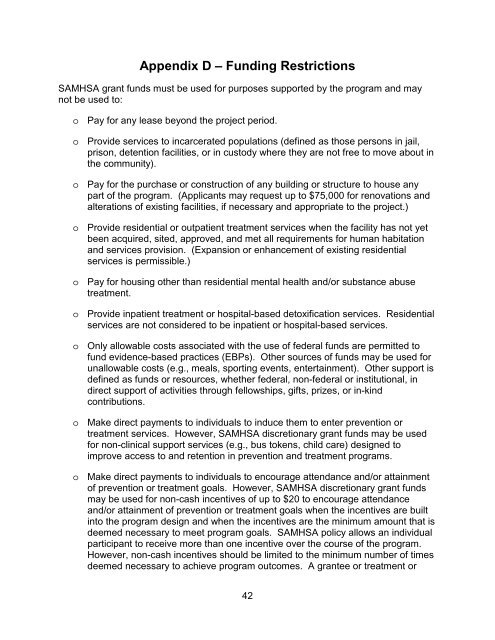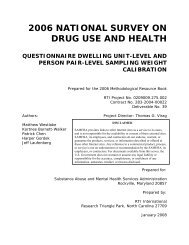Download Complete RFA Announcement (PDF | 351 KB)
Download Complete RFA Announcement (PDF | 351 KB)
Download Complete RFA Announcement (PDF | 351 KB)
Create successful ePaper yourself
Turn your PDF publications into a flip-book with our unique Google optimized e-Paper software.
Appendix D – Funding Restrictions<br />
SAMHSA grant funds must be used for purposes supported by the program and may<br />
not be used to:<br />
o Pay for any lease beyond the project period.<br />
o Provide services to incarcerated populations (defined as those persons in jail,<br />
prison, detention facilities, or in custody where they are not free to move about in<br />
the community).<br />
o Pay for the purchase or construction of any building or structure to house any<br />
part of the program. (Applicants may request up to $75,000 for renovations and<br />
alterations of existing facilities, if necessary and appropriate to the project.)<br />
o Provide residential or outpatient treatment services when the facility has not yet<br />
been acquired, sited, approved, and met all requirements for human habitation<br />
and services provision. (Expansion or enhancement of existing residential<br />
services is permissible.)<br />
o Pay for housing other than residential mental health and/or substance abuse<br />
treatment.<br />
o Provide inpatient treatment or hospital-based detoxification services. Residential<br />
services are not considered to be inpatient or hospital-based services.<br />
o Only allowable costs associated with the use of federal funds are permitted to<br />
fund evidence-based practices (EBPs). Other sources of funds may be used for<br />
unallowable costs (e.g., meals, sporting events, entertainment). Other support is<br />
defined as funds or resources, whether federal, non-federal or institutional, in<br />
direct support of activities through fellowships, gifts, prizes, or in-kind<br />
contributions.<br />
o Make direct payments to individuals to induce them to enter prevention or<br />
treatment services. However, SAMHSA discretionary grant funds may be used<br />
for non-clinical support services (e.g., bus tokens, child care) designed to<br />
improve access to and retention in prevention and treatment programs.<br />
o Make direct payments to individuals to encourage attendance and/or attainment<br />
of prevention or treatment goals. However, SAMHSA discretionary grant funds<br />
may be used for non-cash incentives of up to $20 to encourage attendance<br />
and/or attainment of prevention or treatment goals when the incentives are built<br />
into the program design and when the incentives are the minimum amount that is<br />
deemed necessary to meet program goals. SAMHSA policy allows an individual<br />
participant to receive more than one incentive over the course of the program.<br />
However, non-cash incentives should be limited to the minimum number of times<br />
deemed necessary to achieve program outcomes. A grantee or treatment or<br />
42
















